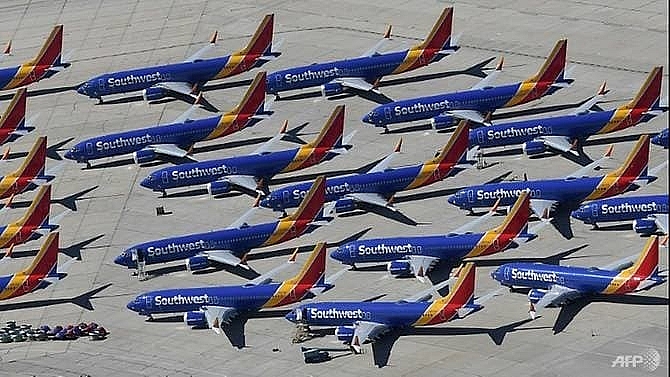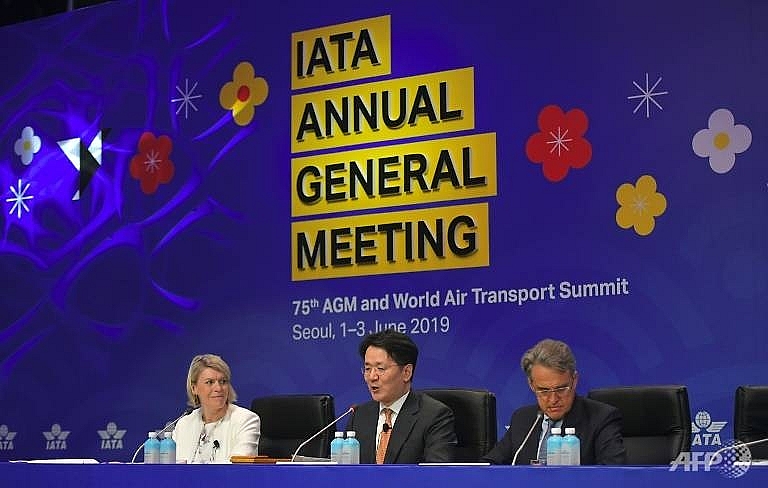Global airline body warns of US-China trade war spillover
 |
| The 737 MAX 8 was grounded by US authorities in March following the footsteps of several other countries AFP/Mark RALSTON |
The warning came at the annual meeting of global airlines in Seoul, where it was revealed that 2019's collective net profit was forecast to be US$28 billion, down from an outlook of US$35.5 billion released in December.
The grim outlook was driven by rising costs across the board, including labour, fuel and infrastructure, the IATA said, adding the worsening trade war between the two global powers was not helping.
"Weakening of global trade is likely to continue as the US-China trade war intensifies," said IATA chief executive Alexandre de Juniac.
"This primarily impacts the cargo business, but passenger traffic could also be impacted as tensions rise," he added.
The world's top two economies have been locked in a trade war since last year, swapping tit-for-tat duties on hundreds of billions of dollars worth of goods and sending markets into a tailspin.
The fallout has reached far beyond their shores, with manufacturing in many export-dependent Asian economies taking a hit.
Brian Pearce, chief economist at the IATA, forecast "zero growth at best" for air cargo traffic this year, noting the impact of the trade tariffs imposed in the first half of 2018.
The Asia-Pacific region, which accounts for around 40 per cent of global air cargo traffic, was "clearly under pressure", he added.
"Cargo is such an important feature that the weakness in trade and the risk surrounding trade will mean profitability will be weaker in this region," Pearce said.
 |
| The IATA, which represents some 290 airlines comprising 82 percent of global air traffic. (Photo: AFP/Jung Yeon-je) |
He painted a "mixed picture" for the region, noting that Asian countries - notably India and China - will lead a "reasonable" five-percent global growth in the passenger business.
Mr Pearce did not rule out a possible industry recession but pointed to the rise in air travel demand and said: "At the moment it doesn't look like we are going to have one in 2019."
"REPUTATION IN THE SPOTLIGHT"
This year's meeting of the IATA, which represents some 290 airlines comprising 82 per cent of global air traffic, comes after two crashes in October and March that left hundreds of people dead.
Both accidents involved Boeing's 737 MAX 8 jetliners, turning the world's largest aircraft maker into a liability that put the industry's "reputation in the spotlight", de Juniac said.
The 737 MAX 8 was grounded by US authorities in March, following in the footsteps of several other countries.
Multiple airlines have indicated they will seek compensation for the fact they could not use the 737 MAX 8 planes in their fleets.
Mr Pearce played down the economic impact of the US jetliner's grounding on the industry, noting the 737 MAX 8 accounted for "less than two percent" of the global fleet.
"So it's actually fairly minor," he said. "It'd be more important to some airlines... but it hasn't been a driving factor."
The IATA chief said last week the troubled jetliner will remain grounded for at least 10 to 12 more weeks, saying the decision was in the hands of the regulators.
Prior to the two crashes which killed 346 people, airline regulators worldwide generally recognised certifications issued by their peer in the country where the aircraft was built, which in this case was the US Federal Aviation Administration (FAA).
Following the crashes however, the Seattle Times reported that the FAA had delegated part of the certification process for the plane to Boeing engineers.
"Trust in the certification system has been damaged - among regulators, between regulators and the industry and with the flying public," de Juniac said Sunday.
"While Boeing and the US Federal Aviation Administration are at centre stage, the close collaboration of counterpart manufacturers and civil aviation authorities around the world are essential," he added.
Acting FAA Administrator Daniel Elwell said after a meeting on May 23 that his administration was more focused on making sure the 737 MAX 8 was safe than in drawing up a timetable for its return to service.
What the stars mean:
★ Poor ★ ★ Promising ★★★ Good ★★★★ Very good ★★★★★ Exceptional
 Tag:
Tag:
Related Contents
Latest News
More News
- First members of Danang International Finance Centre revealed (December 22, 2025 | 17:39)
- Human-centred governance seen as key to AI development (December 19, 2025 | 18:19)
- Top 10 notable events of Vietnam’s industry and trade sector in 2025 (December 19, 2025 | 14:00)
- Tungsten surges to 12-year high as world enters a new 'black gold' race (December 18, 2025 | 17:27)
- Vietnam’s coffee exports set new record despite price pressures (December 18, 2025 | 17:13)
- Garment and textile sector seeks new growth after volatile year (December 18, 2025 | 17:01)
- VinSpeed and Siemens strengthen cooperation for high-speed rail development (December 18, 2025 | 16:53)
- High-tech adoption for TH true MILK (December 18, 2025 | 13:39)
- Takeda supports health resilience amid climate change challenges (December 18, 2025 | 12:39)
- Mondelez Kinh Do - a chapter of purpose-led leadership in Vietnam (December 18, 2025 | 09:44)
























 Mobile Version
Mobile Version